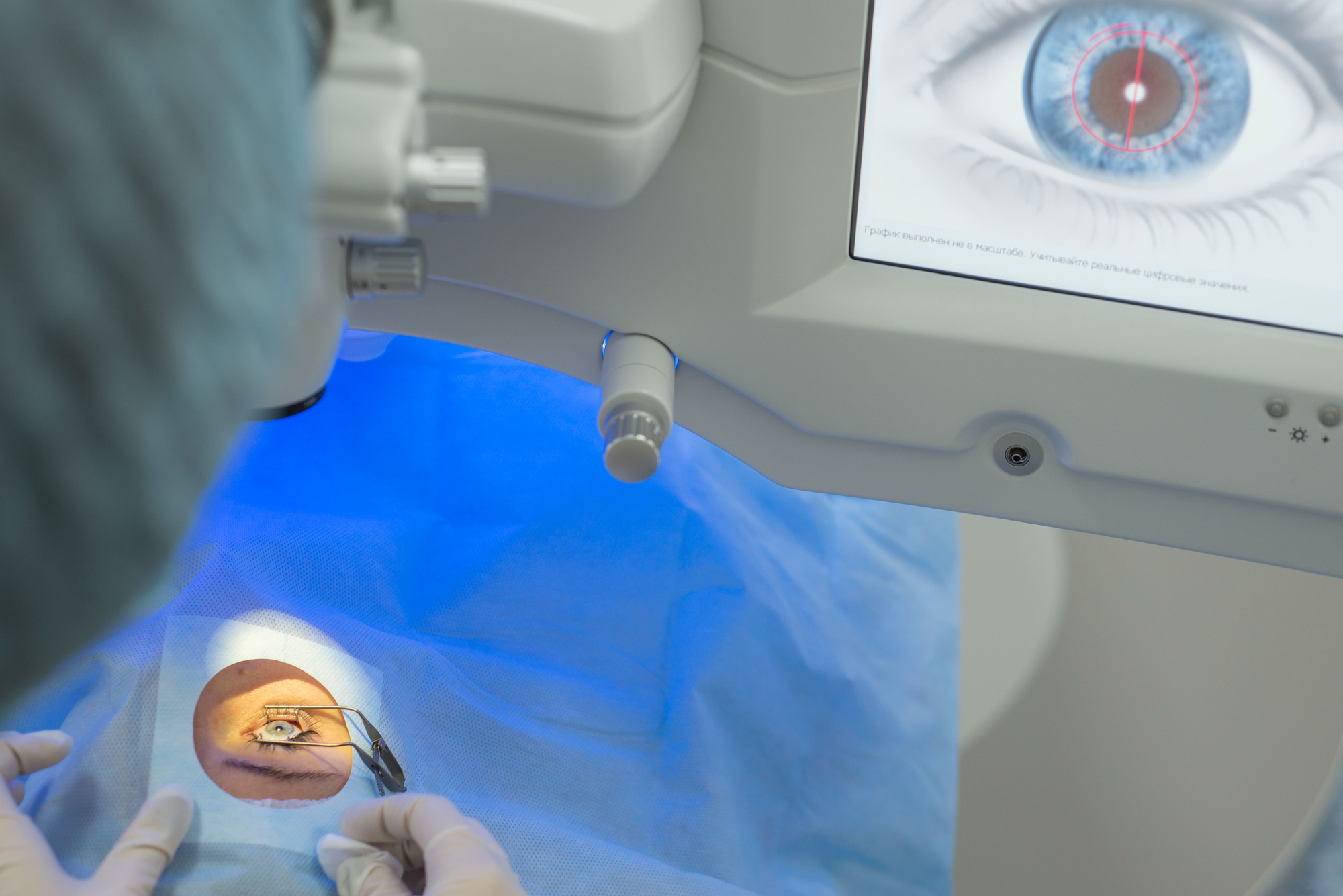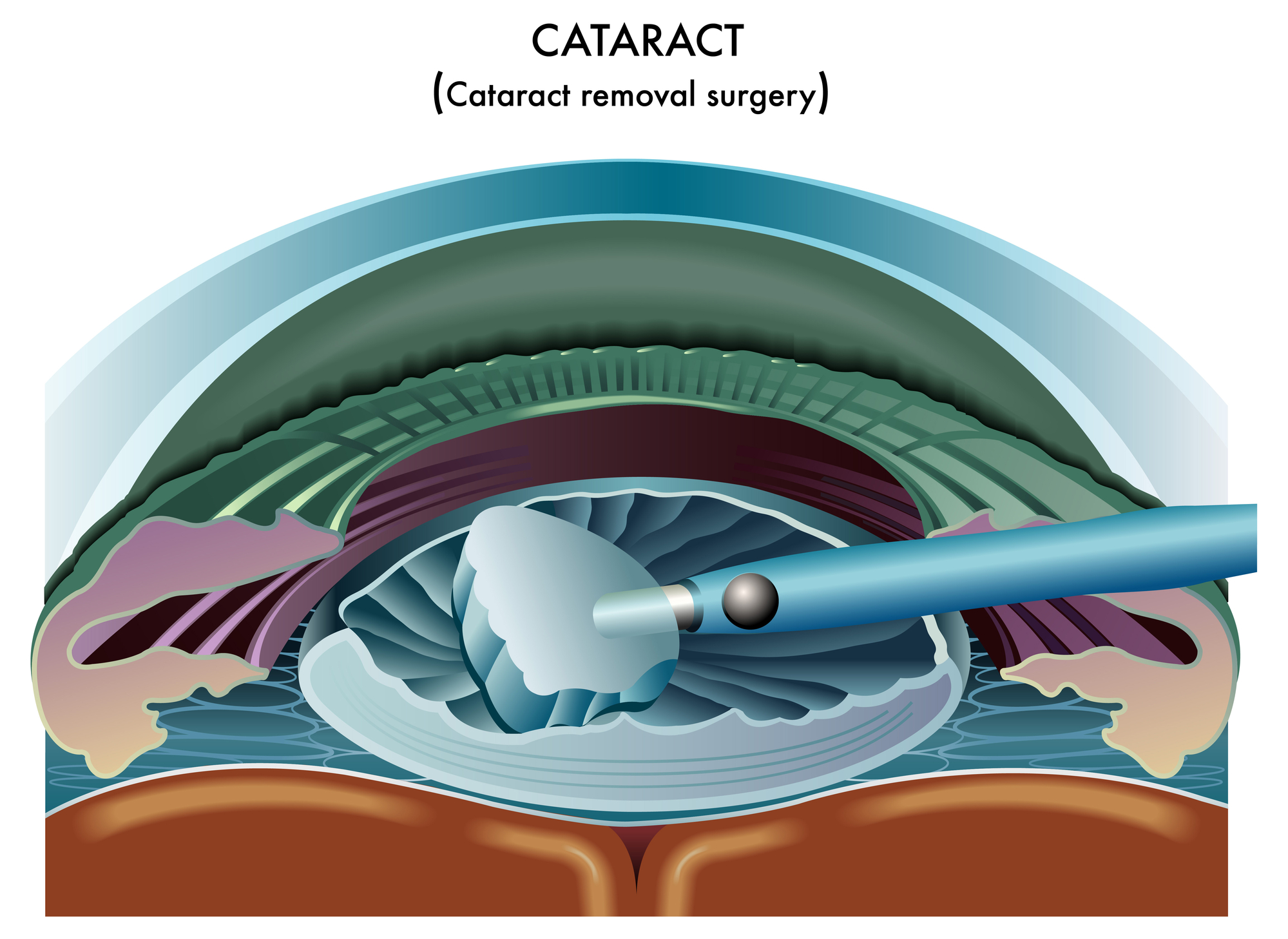Updated on October 21, 2024
Lens Replacement Surgery


Vision Center is funded by our readers. We may earn commissions if you purchase something via one of our links.
Key Takeaways
- Lens replacement surgery is a general term for procedures that enhance visual acuity. It’s often used to treat severe nearsightedness, farsightedness, astigmatism, and presbyopia.
- Two types of lens replacement surgery remove the eye’s natural lens and replace it with an artificial intraocular lens (IOL). On the other hand, the Intracameral lens (ICL) is placed behind the iris.
- The lens replacement surgery cost typically depends on location, facilities, and dental expertise. Although the procedure is more invasive than laser eye surgery, it results in perfect vision.
What is Lens Replacement Surgery?
Lens replacement surgery is a general term for procedures that enhance visual acuity (the ability to see clearly).
They are commonly recommended to address the following refractive errors:
- Myopia (nearsightedness)
- Hyperopia (farsightedness)
- Astigmatism
- Presbyopia (age-related farsightedness)

Types of Lens Replacement Surgeries
The most popular lens replacement procedures include:
- Refractive lens exchange (RLE)
- Cataract surgery
RLE and cataract surgery involve removing the natural eye lens and replacing it with an artificial one designed to improve vision. These eye surgeries aim to improve vision and reduce the need for glasses and contact lenses.
Another notable lens implant procedure is an intracameral lens, also known as an implantable collamer lens (ICL).1 Unlike other procedures, ICL doesn’t involve removing your natural lens. However, it still offers a permanent solution for vision correction.
Listen In Q&A Format
Lens Replacement Surgery
Vision Center Podcast
Difference Between RLE and Cataract Surgery
Both procedures similarly remove the natural lens of the eye. However, there are notable differences between the two surgeries—namely, the intention for surgery and the expectations afterward.
Cataract surgery aims to correct vision issues caused by cloudy natural eye lenses. On the other hand, RLE aims to restore perfect vision and eliminate the need for glasses or contact lenses.
Those who undergo cataract surgery will likely notice improved but imperfect vision. They may need to continue using prescription glasses even after surgery. Additionally, cataract surgery will correct both problems if the cataracts occur with presbyopia.
Refractive Lens Exchange (RLE)
RLE is an outpatient procedure performed in a clinic or doctor’s office. Eye doctors recommend RLE for treating severe cases of refractive errors. It’s sometimes called “clear lens exchange” or “clear lens extraction.”

One advantage of RLE is that it prevents cataracts (clouding of the natural eye lenses). The procedure also eliminates contact lens risks, such as:2
- Dry eyes
- Red eyes
- Irritation
- Eye infections
- Accidental injuries such as corneal abrasions
RLE provides long-lasting clear vision because the artificial lenses do not degrade, and there’s no maintenance required. The refractive lens exchange procedure isn’t reversible.
Candidacy
You may qualify for RLE if you:3
- Don’t qualify for LASIK eye surgery or photorefractive keratectomy (PRK)
- Wish to treat presbyopia (age-related farsightedness)
- Want to get rid of eyeglasses or contact lenses
Procedure
Below is what to expect before, during, and after surgery:
Before Surgery
Days before surgery, your surgeon will thoroughly examine your eyes to ensure RLE is the right procedure. Your doctor might also:
- Take your eye measurements to determine the types of intraocular lenses (IOLs) that will restore your visual acuity
- Discuss the risks and expectations of the procedure
- Recommend steroid and antibiotic eye drops a day or two before the surgery to lower the risk of inflammation or infection.
Additionally, you may be asked to avoid wearing contact lenses or eyeglasses a week before your initial examination. This allows your cornea to return to its natural shape to prevent measurement errors during examination.
If you’re eligible for less invasive LASIK surgery, ICL, PRK, contacts, or eyeglasses, your surgeon may recommend these instead of RLE. Lastly, be sure to raise any concerns that you may have before the day of the surgery.
During Surgery
Your surgeon will administer anesthetic eye drops and mild sedatives to help ease discomfort and help you relax. Afterward, they’ll sterilize the skin around your eye and protect the area with a sterile cloth in preparation for the incision.
With your eyelids held open using an eyelid holder, your surgeon will make a small incision in your cornea. Once the incision is made, they’ll use either an ultrasound or a femtosecond laser to fragment the natural eye lens for easy removal. Then the natural lens is replaced with an artificial one.
RLE is a painless and quick procedure that usually takes about 15 minutes. Prepare reliable transportation to and from the doctor’s office on the day of the surgery. Your ability to operate machinery will be impaired due to the effects of sedation.
After Surgery
You may experience the following immediately after RLE surgery:
- Mild discomfort
- Glares
- Halos
- Blurred vision
These side effects will typically go away as you heal. Most people report clear vision immediately after the procedure. However, it’ll take several weeks to recover fully.
You’ll likely be prescribed steroids and/or antibiotic drops to help prevent infections and inflammation. Wearing an eye patch or a protective eyeshield for a few days to prevent self-injury, especially during sleep, might also be recommended.
After 24 to 48 hours, you’ll need to attend regular follow-up appointments for close monitoring until you recover. Follow your doctor’s post-op care instructions to avoid complications and promote healing.
Refractive Lens Exchange Surgery Cost
RLE costs $3,000 to $6,000 per eye, on average. It’s an elective procedure, so private insurance and Medicare won’t cover it.
The cost may vary depending on a few factors, such as:
- Your location
- Available facilities
- Your surgeon’s experience
Cataract Surgery
Cataracts occur when the clear eye lens hardens and appears cloudy, decreasing the ability to see clearly. Cataract surgery is a common eye lens replacement that treats severe cloudiness. The procedure is most common among older people (50 years or older).5

Studies indicate about 28 million cataract surgeries are performed each year worldwide, with 4 million being in the United States alone.6
Candidacy
You may qualify for cataract surgery if you:
- Are over 50 years old and in the early stages of cataract development
- Have a cloudy eye lens that is affecting your vision
- Wish to reduce the need for contact lenses or eyeglasses
- Have cataracts that are affecting the outcome of other eye treatments, such as laser eye surgery
Cataract surgery might be ineffective if you have cataracts and advanced eye problems, such as macular degeneration or a detached retina.7 However, your doctor can determine your eligibility and risk potential during an eye exam.
Procedure
Below is what to expect before, during, and after cataract surgery:
Before Surgery
While cataract surgery is considered safe, preparation is essential to ensure optimum results and avoid complications.
Before surgery, your eye doctor will examine and measure your eyes using different tools. This will help them identify the appropriate IOLs for you.
Follow these general tips as you prepare for the surgery:
- Stop taking aspirin or anti-clotting drugs, as these may interfere with normal bleeding
- Avoid wearing makeup such as mascara, eyeliners, or artificial eyelashes
- Only wash your face with soap and water on the day of surgery
- Abstain from drinking alcohol at least 24 hours before surgery
- Avoid wearing contact lenses and prescription glasses a few days before surgery
- Set up your transportation to and from surgery (you may experience temporary vision impairment immediately after)
If you take prostate medication such as Flomax, tell your doctor since these alpha-blockers interfere with the iris muscles during cataract surgery.
Like most eye surgeries, your doctor might recommend steroid and antibiotic eye drops a day or two before the surgery to prevent inflammation or infection.
During Surgery
You’ll remain awake during the surgery. Although you may notice motion or lights, you won’t see what the surgeon is doing.
The surgeon will administer medicine to help you stay relaxed and numbing eye drops to prevent discomfort. After that, they’ll use small tools to cut into the eye and remove the lens before replacing it with an IOL.
The surgery is quick and painless, typically lasting about one hour.
After Surgery
Immediately after cataract surgery, minor discomfort or blurry vision is possible for a few days. Many recovering patients report clear vision within a few days after the surgery. But it might take 1 to 2 weeks to see sharper images.
Complete healing occurs within 8 weeks after surgery. Sometimes, cloudiness occurs after surgery (posterior capsule opacification) due to the thickening of tissues holding the lenses.
Posterior capsule opacification develops over several months or years after surgery. To address this, your doctor will recommend a painless laser treatment known as YAG laser capsulotomy.8
Like other eye surgeries, make a follow-up appointment at least 24 to 48 hours after to monitor the healing process closely. Studies on cataract surgery show a success rate of about 99%.9
Cataract Surgery Cost
On average, cataract surgery may cost around $3,500 to $7,000 per eye without insurance.
However, the price varies slightly based on:
- Your region and location
- Available facilities
- The surgeon’s experience
Unlike RLE, cataract surgery is considered medically necessary and is covered by most insurance programs, including Medicare and Medicaid.
Depending on your insurance coverage, you might have to pay out of pocket for deductibles, co-pays, and co-insurance.
Types of Intraocular Lenses (IOLs)
There is no one-size-fits-all when it comes to artificial intraocular lenses. Your surgeon will choose the best option based on what will work best for your situation.
If you need IOLs in both eyes, your surgeon will treat both eyes separately (one to two weeks apart).
The different types of IOLs available for RLE or cataract surgery include:4
- Multifocal IOLs. These are designed to provide near, intermediate, and distant focus simultaneously.
- Monofocal IOLs. These are designed for either medium-range or distance vision, but not all at the same time.
- Accommodating IOLs. These are monofocal lenses but provide clear focus at different distances when you move your eyes.
- Toric lenses or astigmatism correction IOLs. Premium monofocal lenses that help treat astigmatism; these cost more than standard monofocal lenses.
Intracameral Lens (ICL)
Intracameral lens (ICL) or Visian ICL is the latest version of the phakic implants used to correct myopia (nearsightedness) and astigmatism.10

Instead of removing the eye’s natural lens, ICL lenses are placed behind the iris. This enhances the focusing ability of the existing natural lens. The lens is also intended for permanent use, but the procedure is reversible.
ICL lenses differ in shape, size, and consistency compared to standard contact lenses. Visian ICL is ideal for people who don’t qualify for laser refractive surgery. It’s also a preference for those at risk of dry eyes.
Candidacy
You may qualify for ICL surgery if you:
- Are between 21 and 45 years old
- Aren’t a good LASIK surgery candidate
- Have moderate to severe myopia (nearsightedness)
- Have minor to no astigmatism
- Have good general eye health
- Have no history of eye trauma
- Do not take medications such as steroids that can interfere with healing
- Have at least 6 months to a year of unchanged vision correction prescriptions
- Aren’t pregnant or breastfeeding
- Aren’t allergic to local anesthetic eye drops
Procedure
Below is what to expect before, during, and after ICL surgery:
Before Surgery
Just like RLE and cataract surgery, preparation is important. Your doctor will examine your eyes to determine eligibility and provide pre-surgery instructions to ensure you’re ready on the day of surgery.
During Surgery
You’ll sit in a reclining chair, and your surgeon will prepare your eyes for ICL. You’ll be sedated and your eye sterilized.
Your surgeon will make a small incision in your cornea. Then they’ll insert the ICL lens between your iris and natural lens to enhance your natural lens’s focus.
After Surgery
After the procedure, your surgeon will stitch up the incision to hold the lens. This procedure takes about 20 to 30 minutes.
Most people experience clearer vision immediately after surgery. Follow your surgeon’s post-op care instructions to help avoid complications.
Cost
On average, the ICL procedure may cost about $4,000 to $5,000 or more per eye. ICL is considered an elective surgery; therefore, it’s not covered by your insurance.
Similar to RLE and cataract surgery, ICL’s cost may vary depending on:
- Location
- Available facilities
- The surgeon’s experience
How Long Does it Take to Recover From Lens Replacement Surgery?
Your vision will stabilize in about a week or two. You can resume normal activities like reading, watching TV, and driving, but in moderation.
Expect a full recovery in about eight weeks. Successful recovery will depend on your ability to care for your eye after surgery.
If both eyes require surgery, the procedures are typically done on separate days, usually two weeks apart. This also affects the recovery timeline.
Most people achieve clear vision immediately after ICL surgery. But this doesn’t indicate full recovery.
Post-Op Care and Instructions
After a lens replacement procedure, your doctor will provide instructions to help with healing and recovery. This decreases the risk of side effects and complications.
Here are some post-op-care instructions to expect:
- Avoid rubbing your eyes for about 3 to 5 days
- Wear protective gear such as eyeshields or UV-blocking sunglasses
- Avoid makeup, creams, and lotions for some time
- Avoid water contact (e.g., in swimming pools, rivers, oceans, or hot tubs)
- Stay away from strenuous activities such as heavy lifting and contact sports
Possible Side Effects
- Temporary blurring
- Increased sensitivity to light
- Halos and glares around lights
- Mild discomfort
Possible Lens Replacement Surgery Risks
- Retinal detachment, especially in extremely nearsighted people
- Dislocated IOL
- Increased eye pressure (ocular hypertension)
- Severe reddening of the eyes
- Infection or bleeding inside the eye
- Droopy eyelid (ptosis)
- Glare, halos, and blurry vision from multifocal lenses
Lens Replacement Surgery vs. Other Treatments
Lens replacement surgery is more invasive than laser vision correction surgeries like LASIK and PRK. More risks are associated with these procedures, including a prolonged recovery timeline.
The success rate is high (99%), with most people reporting satisfaction with their outcomes. The risks are a worthwhile trade-off if you have high refractive errors and desire perfect vision.
Your ophthalmologist will most likely recommend lens replacement when other treatments aren’t a good fit.
In this article
11 sources cited
Updated on October 21, 2024
Updated on October 21, 2024
About Our Contributors
Vincent Ayaga is a medical researcher and seasoned content writer with a bachelor's degree in Medical Microbiology. Specializing in disease investigation, prevention, and control, Vincent is dedicated to raising awareness about visual problems and the latest evidence-based solutions in ophthalmology. He strongly believes in the transformative power of ophthalmic education through research to inform and educate those seeking knowledge in eye health.
Dr. Melody Huang is an optometrist and freelance health writer with a passion for educating people about eye health. With her unique blend of clinical expertise and writing skills, Dr. Huang seeks to guide individuals towards healthier and happier lives. Her interests extend to Eastern medicine and integrative healthcare approaches. Outside of work, she enjoys exploring new skincare products, experimenting with food recipes, and spending time with her adopted cats.

